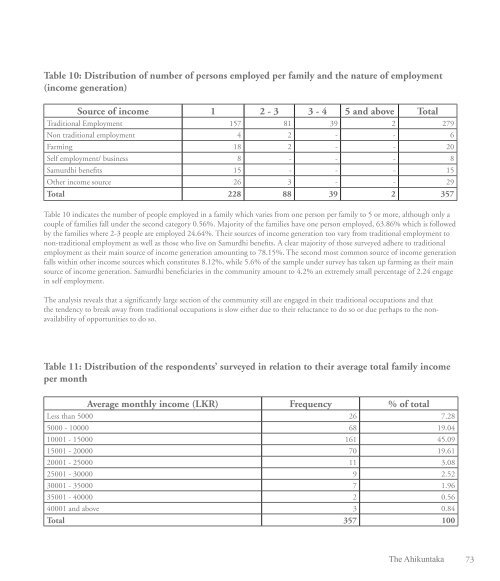The Ahikuntaka
A publication documenting the lives and livelihoods of the Ahikuntaka or gypsy community in Sri Lanka. A collection of vibrant photographs and a baseline survey on the current socio economic status of the Ahikuntaka conducted by the Colombo University complement this timely publication.
A publication documenting the lives and livelihoods of the Ahikuntaka or gypsy community in Sri Lanka. A collection of vibrant photographs and a baseline survey on the current socio economic status of the Ahikuntaka conducted by the Colombo University complement this timely publication.
You also want an ePaper? Increase the reach of your titles
YUMPU automatically turns print PDFs into web optimized ePapers that Google loves.
Table 10: Distribution of number of persons employed per family and the nature of employment<br />
(income generation)<br />
Source of income 1 2 - 3 3 - 4 5 and above Total<br />
Traditional Employment 157 81 39 2 279<br />
Non traditional employment 4 2 - - 6<br />
Farming 18 2 - - 20<br />
Self employment/ business 8 - - - 8<br />
Samurdhi benefits 15 - - - 15<br />
Other income source 26 3 - - 29<br />
Total 228 88 39 2 357<br />
Table 10 indicates the number of people employed in a family which varies from one person per family to 5 or more, although only a<br />
couple of families fall under the second category 0.56%. Majority of the families have one person employed, 63.86% which is followed<br />
by the families where 2-3 people are employed 24.64%. <strong>The</strong>ir sources of income generation too vary from traditional employment to<br />
non-traditional employment as well as those who live on Samurdhi benefits. A clear majority of those surveyed adhere to traditional<br />
employment as their main source of income generation amounting to 78.15%. <strong>The</strong> second most common source of income generation<br />
falls within other income sources which constitutes 8.12%, while 5.6% of the sample under survey has taken up farming as their main<br />
source of income generation. Samurdhi beneficiaries in the community amount to 4.2% an extremely small percentage of 2.24 engage<br />
in self employment.<br />
<strong>The</strong> analysis reveals that a significantly large section of the community still are engaged in their traditional occupations and that<br />
the tendency to break away from traditional occupations is slow either due to their reluctance to do so or due perhaps to the nonavailability<br />
of opportunities to do so.<br />
Table 11: Distribution of the respondents’ surveyed in relation to their average total family income<br />
per month<br />
Average monthly income (LKR) Frequency % of total<br />
Less than 5000 26 7.28<br />
5000 - 10000 68 19.04<br />
10001 - 15000 161 45.09<br />
15001 - 20000 70 19.61<br />
20001 - 25000 11 3.08<br />
25001 - 30000 9 2.52<br />
30001 - 35000 7 1.96<br />
35001 - 40000 2 0.56<br />
40001 and above 3 0.84<br />
Total 357 100<br />
<strong>The</strong> <strong>Ahikuntaka</strong><br />
73















